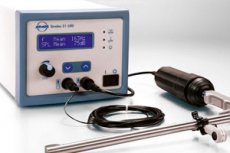Medical expert of the article
New publications
Laryngeal stroboscopy
Last reviewed: 07.07.2025

All iLive content is medically reviewed or fact checked to ensure as much factual accuracy as possible.
We have strict sourcing guidelines and only link to reputable media sites, academic research institutions and, whenever possible, medically peer reviewed studies. Note that the numbers in parentheses ([1], [2], etc.) are clickable links to these studies.
If you feel that any of our content is inaccurate, out-of-date, or otherwise questionable, please select it and press Ctrl + Enter.

Laryngeal stroboscopy is one of the most important methods for studying the movements of the vocal folds, allowing for the visualization of their natural movements in a form adequate for visual perception.
Modern technical means used for laryngeal stroboscopy allow us to “slow down” the visible movement of the vocal folds, “stop” them at any phase of movement, record these movements using video technology with subsequent detailed analysis.
The phenomenon of stroboscopy was discovered in 1823 by the French physicist J. Plateau and independently in 1833 by the German scientist S. Stampfer. In 1878, the French laryngologist M. Ortel first performed a stroboscopic examination of the larynx during indirect laryngoscopy using a Garcia mirror.
In recent years, in connection with new technological developments of the Danish company Bruel and Kjaer, which produces multi-purpose video stroboscopes, the problem of laryngeal stroboscopy has received further development. It should be noted, however, that the essence of the stroboscopy method is not something that changes the movement of the vocal folds themselves, since this is impossible in principle. The method is based exclusively on the physiological properties of the visual organ and the corresponding light effects, allowing the fragmentation of the picture of the movements of the vocal folds and adapting it to the physiological capabilities of the human eye.
The stroboscopic effect is the result of a purely physiological phenomenon that manifests itself in the observer's visual system, a kind of visual illusion that occurs when a continuously moving object is periodically illuminated.
The essence of the illusion is that the observer sees the given object as moving in jumps, since the intermediate movement of the object between these jumps falls out of the perception of the overall picture of smooth movement due to the periodic absence of illumination of the observed object. The perception of movement in jumps occurs in the case when the periods of absence of illumination are sufficiently long and exceed such a physiological phenomenon for the organ of vision as the critical frequency of fusion of light flickers. The fact is that visual perception is characterized by a certain inertia, manifested in the fact that after exposure of a stationary object, for example, with the help of a flash of light, the observer "sees" this object in the absence of illumination for another 0.143 s, after which this image disappears. If the time of unillumination is more than 0.143 s, then the object will periodically appear and disappear, if the frequency of light flickers is such that the period of unillumination is less than the specified value, then the object will be perceived as constantly illuminated, i.e. its perception will be continuous.
The above is also true for a moving object, with the only difference being that during the darkening period the object has time to move to a new location, and if the period of movement is more than 0.1 s, then the movement of the object will be perceived as jerky, if less, then smooth and continuous.
Thus, the smoothness or jerkiness of the object's movement when it is periodically illuminated depends on the frequency of light flickering and on the inertia of the visual organ, which preserves the image seen for 0.1 s. By changing the frequency of illumination of a moving object, it is possible to obtain several types of stroboscopic effect - slow forward movement (in the direction of actual movement); the effect of object immobility; slow backward movement, etc. It is also possible to obtain the effect of jerky forward or backward movement, but for this it is necessary that the period of non-illumination be greater than 0.1 s.
Laryngostroboscopic examination of the larynx is carried out using special devices called stroboscopes. Modern stroboscopic devices are divided into mechanical or optical-mechanical, electronic and oscillographic. In medical practice in the last decade of the 20th century, videostroboscopic installations with wide multifunctional capabilities have become widespread.
In pathological conditions of the vocal apparatus, various stroboscopic pictures can be observed. When assessing these pictures, it is necessary to take into account the level of the position of the vocal folds, the synchronicity and symmetry (mirror) of their vibrations, the nature of their closure and the timbre coloring of the voice. Modern video stroboscopic devices allow recording a dynamic stroboscopic picture of the larynx simultaneously with the sound being recorded and then performing a thorough correlation analysis between the movement of the vocal folds and the frequency characteristics of the sounding voice.
Normally, during stroboscopy, the vocal folds are visualized at the same level. In some diseases, most often of a functional nature, the vocal folds are located at different levels, and the more affected fold seems to be located higher.
This phenomenon is revealed only by stroboscopy, which also allows us to identify the so-called nodes of vocal fold vibrations, i.e. areas that shift with maximum amplitude. It is in these areas that singers or teachers develop so-called singing nodules. With the help of stroboscopy, it is possible to differentiate the movements of the vocal folds by their nature and form, i.e. whether they vibrate along their entire length or only partially, in the anterior or posterior sections, in their entire mass or only in the free edge, etc.
What do need to examine?
How to examine?


 [
[